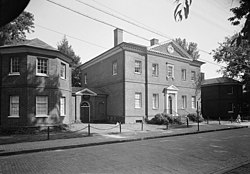Hammond-Harwood House
|
Hammond-Harwood House
|
|

Exterior view of the Hammond–Harwood House
|
|
| Location | Maryland Ave. and King George St., Annapolis, Maryland |
|---|---|
| Coordinates | 38°58′51″N 76°29′19″W / 38.98083°N 76.48861°WCoordinates: 38°58′51″N 76°29′19″W / 38.98083°N 76.48861°W |
| Area | 0.5 acres (0.20 ha) |
| Built | 1773 |
| Architect | Buckland, William |
| Architectural style | Georgian |
| NRHP Reference # | 66000384 |
| Significant dates | |
| Added to NRHP | October 15, 1966 |
| Designated NHL | October 9, 1960 |
The Hammond–Harwood House is a historic house museum at 19 Maryland Avenue in Annapolis, Maryland, USA. Built in 1774, is one of the premier colonial houses remaining in America from the British colonial period (1607–1776). It is the only existing work of colonial academic architecture that was principally designed from a plate in Andrea Palladio’s I Quattro Libri dell’Architettura (The Four Books of Architecture) (1570). The house was designed by the architect William Buckland in 1773–74 for wealthy farmer Matthias Hammond of Anne Arundel County, Maryland. It was modeled on the design of the Villa Pisani in Montagnana, Italy, in Book II, Chapter XIV of I Quattro Libri dell’Achitettura. It was designated a National Historic Landmark in 1960, and is now managed by a non-profit organization as a museum.
Construction on the house began in, or around, April 1774 and a majority of the house was probably completed before the death of the architect in November or December of the same year. Patron Matthias Hammond probably never occupied his elegant house because he abruptly left Annapolis for his family's country estate in 1776. He died in 1786 after renting the house for many years.
The house passed to his nephews John and then Philip Hammond who eventually sold the house to Ninian Pinkney in 1810. Pinkney, however quickly sold the house to Judge Jeremiah Townley Chase in 1811. Judge Chase bought the house as a home for the family of his daughter Frances Townley Chase Loockerman. He was well acquainted with the house because he rented the northeast wing beginning in the late 1770s.
...
Wikipedia


